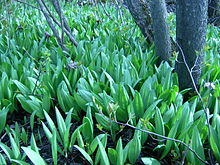Allium tricoccum
| Allium tricoccum | ||||||||||||
|---|---|---|---|---|---|---|---|---|---|---|---|---|

Allium tricoccum |
||||||||||||
| Systematics | ||||||||||||
|
||||||||||||
| Scientific name | ||||||||||||
| Allium tricoccum | ||||||||||||
| Aiton |
Allium tricoccum is aplant species similarto wild garlic from the genus leek ( Allium ) within the amaryllis family (Amaryllidaceae).
The edible, garlic- smelling plant is native to eastern North America , where the common English names ramp or wild leek are used. It is a traditional part of the cuisine in parts of the United States and Canada.
description
Allium tricoccum grows as a perennial , herbaceous plant . Two to six, about 1.5 to 6 centimeters long and 1.5 to 3 centimeters wide, conical to egg-shaped bulbs serve as storage and persistence organs. In addition, short rhizomes are usually formed. The outer brownish to grayish onion layers consist of fine-fiber cells and enclose one or more onions. The cells of the inner white onion layer are arranged irregularly and have an indicated network-like structure.
The short-lived, two to three basal leaves are narrowly stalked. They develop a length of (15–) 20–30 (–40) centimeters, their width measures 1.5 to 9 centimeters. The smooth, entire blade is elliptical to lanceolate. It narrows towards the top.
Per plant, on a permanent, upright and somewhat twisted, 15 to 40 centimeter long and 2–4 millimeter wide inflorescence stalk (6–) 30–50 small, bell-shaped, whitish or yellowish flowers are formed. They stand together in an inverted-conical to hemispherical umbel . There are no brood onions. The permanent bracts of the inflorescence are designed as spathe . They are veined two to three times, lanceolate to lanceolate and egg-shaped and roughly the same size. They have a pointed tip. A beak is not developed.
The 10 to 20 millimeters long stalked flowers are about 4 to 7 millimeters in size. The six full-margined, elongated to egg-shaped, straight bracts of the flower stand in two circles and are designed the same. They have a blunt tip. The fertile stamens , arranged in two circles of three each, are about as long as the bracts. They have white to light yellow anthers that release white pollen. The upper ovary consists of three fused carpels. The linear style is shorter than the stamens, it does not protrude from the flower. It closes off with a heady, unlapped and barely thickened scar.
A three-compartment capsule forms as the fruit . Each compartment contains a smooth, round, black seed 2.5 millimeters in diameter.
The number of chromosomes is 2n = 16.
Way of life and ecology
The leaves of Allium tricoccum develop as soon as the snow melts and wither after the leaves shoot. At this point, the peduncle is formed. There are usually no leaves left by the bloom time in July. The fruit ripens at the beginning of September. The seeds only germinate in the autumn of the next year after they have been scattered. The first leaf, the size of a blade of grass, develops in the spring of the following year. Six to ten years can pass between germination and the first flowering.
Allium tricoccum occurs in large stands in its growing habitats. The intense garlic smell, which is noticeable around the colony, is striking.
Allium tricoccum is pollinated by insects . It spreads by gravity and via animals . Large plant specimens can reproduce vegetatively by dividing the bulbs.
supporting documents
- ↑ a b c d Dale W. McNeal Jr., TD Jacobsen: Allium. In: Flora of North America Editorial Committee (Ed.): Flora of North America North of Mexico . Volume 26: Magnoliophyta: Liliidae: Liliales and Orchidales . Oxford University Press, New York / Oxford a. a. 2002, ISBN 0-19-515208-5 , Allium tricoccum , p. 234 (English, online ).
- ^ Cultivation of Ramps . North Carolina State University . Archived from the original on March 26, 2014. Retrieved February 19, 2014.
- ↑ a b c d e Developpement durable, Environnement, Faune et Parcs Québec: Allium tricoccum
- ^ Tropicos. [1]
- ↑ a b Quebec Nature repertoire : Allium tricoccum

